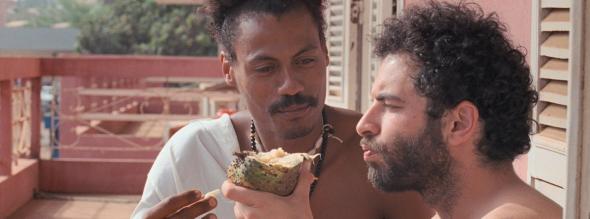Seeing is a slow verb. A (neo)postcolonial essay on time, gaze, and discomfort.
Seeing is a slow verb. A (neo)postcolonial essay on time, gaze, and discomfort.
Note to cinephiles: this text will take you about ten minutes to read—or put another way, roughly 3% of the minutes you’ll spend watching the full length version of I Only Rest in the Storm.
*******
I Only Rest in the Storm, Pedro Pinho’s hypnotic and rigorous mammoth of a feature, was for me at first a murmur in the editing suite. Not in Cannes, where it premiered, nor in Paris, where it dazzled audiences on the silver screen, but right there in its emotional ground zero, downtown Lisbon, where Pedro had for weeks been submerged under eight hours of material, anguishing over the edit, exhausted, yet resolute. Emotionally situated somewhere in between a dark sense of humour and a certain kind of despair found only in a director at the end of their rope, Pedro remarked that if, in the end, no one else screened the film, he would show it at Cinema do Tédio (literally: Tedious Theatre), the cinephile space he runs in the Bairro Alto district. An aptly named venue, one might add, for slow, auteur cinema. “Man, cinema is almost dead, anyway” he told me, half-laughing, “so I might as well make the film I want to make.”
The day I stopped by the editing suite, they were working on a twenty-minute sequence that wouldn’t make it into the short version. That is, to the 217-minute cut. On screen: three bodies, three temperaments, talking, provoking, measuring each other. I watched in silence for half an hour while Pedro debated options with editor Rita M. Pestana. From the outside looking in, it struck me as a wildly magnetic scene, where nothing happened and yet everything did. This, I thought, was how reality was able to breathe when unconstrained by a strict script. It was a slow, tense, tingling scene. Twenty minutes long, not one minute more than it needed.
Pinho edits like someone trying to resurrect time. He lets the air move around, the pulse throb, the gaze drift and rebound. He doesn’t cut away to accelerate —he cuts as an act of honesty. A radical gesture, in a world where even indignation must fit inside a clip.
So yes, let’s start with the elephant in the room—or rather, the mammoth in the room: I Only Rest in the Storm indeed runs a whooping 217 minutes in the version that premiered in Cannes and toured Paris, New York, Busan, and Rio de Janeiro. It will now have its full-length world premiere at DocLisboa, sitting pretty at a modest five and a half hours of film. A film as long as the moral hangover of the empire. A film that doesn’t ask you for your patience; it demands your presence.
Let’s leave the darkness of the editing suite behind and step into the perfumed air of summer in the south of France. In Bayonne, Basque Country, in an old-fashioned riverside arthouse theatre packed with cinephile types. Or a week later, at midnight in Paris, in a commercial theatre two blocks from the Pompidou, small but bursting at the seams. On the way out, amid the satisfied (and slightly fatigued) murmur of people leaning against wall posters and pillars, I overheard comparisons with Portuguese luminaries such as that other Pedro—Costa, of course—as if the country could only sustain one standard-bearer for slow-paced, attentive cinema. I smiled inwardly: I Only Rest in the Storm has another temperament altogether. It breathes the present, it’s hotter, messier, more impure, more contradictory. Without asking permission, it also stretches time beyond the reasonable, allowing contradiction to reveal itself.
At its core, what film is this, then? Sérgio, a Portuguese environmental engineer (but honestly, he could have held any other technical job), travels to a West African city under the pretext of an environmental impact study for a new road linking desert and forest, crossing Mauritania and Guinea-Bissau. In Bissau, he quickly becomes entangled in a fragile triangular relationship with two people—Diára and Gui—realizing, late and with a jolt, that the project that brought him there carried a historical weight no report could contain. It’s a simple and truthful device––I say this as someone who has worn Sérgio’s shoes (kind of, more on this later). This isn’t, however, a film about building roads, literal or figurative, but about building perceptions, alliances, and decoys in a region where the colonial inheritance and neoliberal versions of “development” strike like sparks on dry wood. (Festival programmes don’t attempt to sugarcoat this framework: “217 minutes following a Portuguese man”, they say, who “grapples with the capitalist and post-colonial dynamics around him” and gets lost between worlds…)
Perhaps that’s why the film’s length imposes itself as an ethical rather than aesthetical choice. The 217 minutes of the festival and theatrical cut represents no whim, no pose: it’s method. As an American critic wrote, the runtime “feels intimidating,” but this is what allowed Pinho to build a film that “sprawls, digresses, and loops back in, like life itself,” in a mosaic of encounters and misunderstandings that can’t fit into that obedient two-hour format. In another write-up, the NYFF program insists on the film’s scale: “epic, unflinching, sexually fluid,” and—note this—“cut to the bone, scene by scene.” In other words: form here doesn’t really hide the theme; the theme sculpts the form.
If one hazards a guess, that’s probably why the full-length version—clocking in at those modest 330 minutes—premiering at DocLisboa Festival (October 25th), interests me so much: less as a cinematic curiosity and more as an overtly political assertion of gaze. The festival program is rather explicit: the same emotional triangle (Sérgio, Diára, Gui), the same laboratory of neocolonial dynamics, the time now stretched out to the limit of discomfort. Five and a half hours, and not a minute less.
 Cortesia Uma Pedra no Sapato e Terratreme
Cortesia Uma Pedra no Sapato e Terratreme
On the point of time, I may be able to provide insight: having been in that edit suite as a stunning twenty minutes of fluid conversation, seduction, and sensuality were edited, I can say I was mesmerized by the elegance of this fly-in-the-wall cinematic moment. Yet, that scene wound up on the cutting-room floor. It was long, fair, spellbinding even. Not enough to fill twenty of those precious 330 minutes. Herein lies the film’s intelligence: allowing the experience to gain density, pauses and contradictions and all, rather than allowing itself to be co-opted into a specific time or a specific thesis. Pinho films time trickling by, returns it to the dialogue, and makes it a thing that is not a thing. In a later (and very long) car scene anchored by a harsh argument on postcolonial morals and do-gooderism—a raw, visceral dialogue between Sérgio and Diára that lives rent-free in my head, each word she hurls at clueless, well-intentioned Sérgio still echoing—what stands out isn’t the message or the time it took her to convey it (very clearly), but the all-too-real friction between two people who see different worlds through the same window.
Yes, the people. Let’s start with Diára. Cléo Diára signs a historic role here. Not as a token of diversity on a European poster, but because she carries in her the contradiction of her POV, never throwing it back at the viewer as pedagogy. She’s simply magnetic, sensitive, at times insolent, provocative; or as a NYFF text puts it, she “mixes strength, sensuality, and vulnerability” and stands out as the film’s emotional backbone. It’s no surprise she won the Best Actress Award in Cannes’ Un Certain Regard section, a gesture of resonance for a Capeverdean-Portuguese actress working in a circuit where legitimacy is still a bareknuckle spar. Those New York critics went further: a “fierce” and “star-making” role. All true.
On the other side of the triangle, Gui—a non-binary Brazilian body, rarely seen with such depth and fairness in a Portuguese film, or in any film for that matter — projects a presence at once affirmative and fractious. Far from a decorative representation we see all-too-often, here Gui is clear positioning, risk. There is electricity flowing between Diára and Sérgio, but it is Gui that eventually appears to be the cable harnessing and redistributing it. This is a foundational, vital role, especially so in the gaps where Pinho refuses to explain and prefers to observe––and let us observe.
And as to Sérgio? He is, indeed, a difficult mirror for a certain kind of audience. Within him lives the “good European” bringing method and a touch of naïve idealism; within him lives also the condescending type who doesn’t quite know what he doesn’t know; within him lives a frightened animal who clings to moral conundrums when reality slips through his fingers. An American critic clocked a brutal(ly) truthful line by a sex worker with whom Sérgio lies, aptly illuminating him as an agent with tainted morals: “What most disgusts me are the good men [like you],” highlighting that trail of good intentions that is the contemporary liberal’s favourite stumble. And, boy, is this ever a film that loves to film the fall. This is also why the confrontation with Diára—outraged by the out-of-place moral superiority of the expat worker and by the lucid anger of someone who lives in the complex cost of “progress”—hits so hard. I’ve seen many versions of this conversation in real life, live and in colour, all over Africa; few, if any, on screen.
 Cortesia Uma Pedra no Sapato e Terratreme
Cortesia Uma Pedra no Sapato e Terratreme
Some accuse the film of didacticism, of being “too obvious,” of “articulating postcolonial lessons” with too much clarity (the nerve), as if it needed to justify its being “in Africa.” I understand the discomfort, welcome it even: it’s a telltale sign that the film doesn’t soften its blows. These critiques must be read with caution, especially as they contradict one another. One harsher write-up argues that I Only Rest in the Storm gets stuck in binaries and has “an educational impulse, on the nose.” Another highlights the opposite: its a long “polyphonic” drift that exposes mechanisms of domination “without easy answers,” refusing “moral comfort.” In yet another, also from New York, I read that its scale “permits detours and returns,” building a mosaic of “uncomfortable truths” impossible to reduce to a two-line thesis. So, which is it? Too simplistic? Too complex? Didactic or polyphonic opus? When the most assertive readings cancel each other out, I distrust the viewer’s discomfort rather than the film itself.
That discomfort grows exponentially around the topic of whites in Africa “for work”—the so-called expats, we’re told. They come in all stripes, of course, but the Portuguese road workers in Sérgio’s project, are portrayed without any sort of absolution. There’s no redemptive psychology that can explain away vulgarity. What there is instead is the vice and the baggage of raw language, crude racism, and, well, the belief in impunity.
Perhaps I should share my own positionality at this point: I’m a light-skinned, light-eyed Luso-Capeverdean— white-passing, as some say —and it is no coincidence that I recognize every gesture on screen. I’ve worked across the continent with NGOs and international agencies and have too often lived in that uncomfortable fold where European expats “relax” around me, thinking they’re among their own, and let the varnish peel off. I’ve heard a thousand things I’d rather not have heard, and that I will never repeat. I’ve had countless internal debates on when to call out an expat on a wonton comment. And when not to. It’s the eternal liminal role of the insider-outsider. That’s also why this film interests me so much: it’s not so much about colonizers and colonized, but about that middle space, and about the affective machinery that allows extraction to continue, now in soft power mode, all between partner nations, you know, friends, but with neoliberal biographies and chunky NGO salaries. This isn’t, mind you, uniquely Portuguese or even uniquely European. Witness that excruciating scene in which a pack of white “aid” workers—young, undefined nationalities—visit their model project-village in Guinea-Bissau to check out the new communal latrines the NGO had installed, surrounded by a group of Elders, mostly women in honour dress, whom they (insistently) ask how exactly they intend to use said latrines. These are Europeans. I’ve seen them also as Americans and Canadians in Haiti. All of them: tropes of a score of others. It is so cringeworthy, and yet so real, I could barely make myself watch. In real life, out in the field, I would have understood the Mamis in Kriolu, when, between their teeth, they must have muttered, “These motherf*ck*rs…” (And I wouldn’t judge them.)
There is still ample room for yet another layer: the local elite. Cosmopolitan, well-spoken, foreign-educated, pragmatic in their alliances, compromised by their interests. The Horácios of this world, of whom I’ve known more than a few. The film observes them too, sharply, avoiding get-out-of-jail cards. They live in a place where the rhetoric of progress coexists with calculation, the liberation of economic independence with the oppressive modernity that sometimes repackages an old economy of favours. Pinho doesn’t deliver a crude denunciation here, but an anatomy without anaesthetic.
What unites these all these worlds—Diára, who knows how to read the city from within; Gui, a fluid oscillation; Sérgio, who wants to do good and doesn’t quite know how, the expats, the local elites—is the refusal of moral abbreviation. Pinho gives all these conflicts enough time to reveal their macrostructure. Time is a blessing.
Formally, the film confirms my intuition: when the camera makes allowances for time as a blank canvas, reality ceases to be an extra and becomes protagonist. Critics at NYFF spoke of an “almost-documentary” tone in certain passages. Fair observation. Indeed, it’s certainly no accident that the full-length version premieres at a documentary festival. What is also interesting to me is how that near-documentary quality serves the opposite of exoticizing. Arguably the film’s cleanest political gesture is its refusal to zoom in on the Other as a scenic curiosity. The camera doesn’t grant the white viewer the quick relief of empathy as catharsis. There’s no uplifting arc. This too is an editing decision.
There are, of course, those who won’t stand for this. There are audiences—and critics galore—for whom three and a half hours of film is a true offense to the industrial entertainment apparatus; others for whom five and a half hours will feel like pedantic provocation. But I see it differently: Pinho’s film doesn’t ask you for patience; it asks you to be present, to sit in the discomfort. Its duration isn’t a medium—it’s the subject. See, the thing is, the violence of history and economy doesn’t fit inside pocket-sized morality. Which is why the rhetoric of “boredom” around watching such a long film bothers to no avail. What’s boring is the haste with which this rote conversation is repeated.

Context matters immensely. So, here’s some context: the film reaches Portugal in the hangover of a political cycle where the far-right grew stronger, public discourse hardened, and political debate turned into a contest of resentments populated by the same pedestrian, white-brand local Trumpists as everywhere else. Dull. It will suffice to walk out of a theatre after a screening and listen to the discomfort in some of the crowd’s murmurs. The fact that Cléo Diára’s victory at Cannes was read in some spaces as a major gesture to diversity says less about quotas and more about the hunger for a different grammar. Across the aisle, of course, the usual noise, the usual trolls, the same, tired lines. I won’t give them a stage. The film does that better, by dismantling, hashtag-free, the European good conscience that believes itself so spotless.
It’s important to underline that I Only Rest in the Storm isn’t a film “against” anyone. It’s against a kind of ease, yes—the ease of imagining that to merely look is to understand, that to measure is to repair, that to pay is to absolve. There are moments of sincere eroticism. Critics have noted it, and I have noted it, particularly one tantalizing scene that is perhaps among the most erotic—or explicit— I’ve seen on screen. There are moments of weary tenderness, and a supreme loneliness that clings like sweat. Pinho knows that desire is political too, and that intimacy is the last laboratory for temptation and power. The triangle, therefore, isn’t a romantic subplot, but a seismograph.
The critical reception abroad has been fascinating to watch. There are readings that celebrate this film as a “milestone” gesture in confronting Portugal’s colonial past. Others that recognize its visual hypnosis and moral ambiguity without concessions. Others who point a finger at its didacticism, its pickaxe. I accept all those voices, but return this question to them: what kind of cinema do you actually want? A film that holds your hand down the corridor only to leave you, at the end, with a perfumed soul? Or a film that keeps you glued to your seats, sweating, thinking to yourself that you’re not quite sure what to do with what we’ve just seen? And how will the film—and the hard questions it poses—play out in Portugal?
Back to the edit. I saw the film twice, in different theatres, each time with friends of varying ages, backgrounds, professions, and political outlooks. Both times, we stepped out into the warm night with the same word on our lips: “Wow…” That isn’t fireworks, it’s perplexity. As the conversations settled (on the way home, on the phone, even days later), the dots began to connect: Cléo’s courage and how the camera gives her txon— Kriolu for ground, roots; the apparent zigzags of certain passages that discreetly weave the ethical cartography of a complex city; the portrayal of the Portuguese workers on the construction site; the austerity and ruthlessness of having no final lessons; and, yes, the programmatic gesture of premiering the full-length version at a documentary festival.
As a filmmaker who also edits slowly and likes shots that breathe, I recognize a lineage here. This isn’t Dogme for Dogme’s sake, slow and shaky, nor is it Solondz’s social sarcasm. It’s something entirely different: it’s the ethics of attention to detail. At a cost, which the film demands we pay. When we go back to its short version (reminder: 217 minutes long), we realize this mammoth has nerve and precision, with a clear skeleton, a progression, a coherence of world that holds even as the narrative opens side paths.

A final note on Cléo Diára, not as a symbol, but as an actor—and it’s as an actor that she interests me here. Her victory at Cannes wasn’t a “diversity win,” rather a well-deserved consecration of a performance in which she carries an immense film on her back, never succumbing to convenience. She represents no one. She presents herself as a whole person, with an economy of gestures and an emotional intelligence that cuts through the frame. Among all these bodies moving through the city, she’s a woman saying no to easy equivalences. She’s not playing the local saint, not the exotified victim, and most definitely not a life-vest for the lost, deer-in-the-headlights European (a role in which, I’ll add belatedly, Sérgio Coragem is truly sublime). Diára is an actor with agency, desires, fatigue, ambitions, and limits. Awards matter because they add cultural capital and, in a country still learning to see its Diáras, an international consecration changes the grammar of the possible. So, for the record: “Best Actress – Un Certain Regard – Cléo Diára.” It’s etched in stone.
At this point, I will accept the note that one occasionally hears: this kind of cinema “isn’t for everyone”, they say. No, it isn’t. And that’s a good thing. Not everything that matters should comfort. A film that sets out to look directly at the harsh reality and has the audacity to return time to that gaze, cannot end with a pat on the viewer’s back. If we leave that theatre feeling uneasy, if we need two walks around the block, if the conversation only truly begins the following day, maybe––just maybe––it’s because this cinema has done what it should. If you didn’t do your stretches, you should have.
I Only Rest in the Storm isn’t meant to make us feel good. It’s meant to make you feel. And think. And, if possible, shift a little—a few millimetres, sometimes a whole kilometre —in how we look at the country, the continent, our history, and our own biographies.
Some films ask for applause. This one asks for responsibility. Discomfort isn’t its flaw, it’s its method. Its duration isn’t the whim of a pedantic filmmaker, but the sine qua non condition of that responsibility. That’s why, when I think of that “elephant” of a runtime, I can only see it as a mammoth, an ancient creature now on screen to remind us that time is not a TikTok clip, but a space where truth (if we’re lucky) breathes.
P.S.: The full-length version screens at the DocLisboa Festival on October 25th. The theatrical version premieres in Portugal on October 30th. Both are worth watching, not to tick a box, but to understand how a film can refine itself without betraying its core, and how, a country (sometimes) learns to see when cinema, stubbornly, fearlessly, shows it the truth.
***
Notes and Credits
Cast: Sérgio Coragem, Cléo Diára, Jonathan Guilherme, Jorge Biague, Binta Rosadore, Nastio Mosquito, Giovanni Maucieri, Marçalina Djibril, Roxana Ionesco, Marinho de Pina, João Santos Lopes, Hermínio Amaro, Paulo Leal, João Pedro Sousa, Hamed Nah, Renato Sztutman, Bruno Zhu, Kody Mccree, Valentina Cirelli
Director: Pedro Pinho
Written by: Pedro Pinho, Miguel Seabra Lopes, Luísa Homem, Marta Lança, José Filipe Costa, Miguel Carmo, Tiago Hespanha, Leonor Noivo, Luís Miguel Correia, Paul Choquet
Cinematography: Ivo Lopes Araújo
Sound Director: Jules Valeur
Production Management: Eduardo Nasser
1st Assistant Director: Tiago Hespanha
Art Direction & Costume Design: Camille Lemonnier, Livia Lattanzio, Ana Meleiro
Make-up, Hair & Character Design: Ami Camará
Editing: Rita M. Pestana, Karen Akerman, Cláudia Rita Oliveira, Pedro Pinho
Colour Grading: Claudiu Doagă
Sound Editing: Pablo Lamar
Sound Mixing: Marius Leftarache
Producers: Filipa Reis, Tiago Hespanha, Pedro Pinho
Production Companies: Uma Pedra no Sapato, Terratreme Filmes
Co-production: Still Moving, deFilm, Bubbles Project
Funding & Support: Instituto do Cinema e do Audiovisual (ICA), Aide aux Cinémas du Monde – CNC – Institut Français, Centre National du Cinéma et de l’Image Animée, ANCINE – Agência Nacional do Cinema (Brazil), Banco Regional de Desenvolvimento do Extremo Sul, Fundo Setorial do Audiovisual, Centrul Național al Cinematografiei România, Rádio e Televisão de Portugal (RTP), Programa Ibermedia, Carrefour, Havas Media, Fundo de Apoio ao Turismo e ao Cinema, Programa Garantir Cultura, Creative Europe MEDIA (European Union), Avanpost Media
National Sales: Magenta / Uma Pedra no Sapato
International Sales: Paradise City Sales
Runtime: 217 minutes (theatrical version); 330 minutes (full version, DocLisboa)
Languages: Portuguese, Creole, French, English
World Premiere: Cannes Film Festival 2025, Un Certain Regard
World Premiere (Full Version): DocLisboa 2025